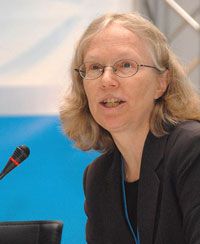Publication of The Agricultural Model Intercomparison and Improvement Project (AgMIP): Protocols and pilot studies in the journal Agricultural and Forest Meteorology,
March 15, 2013.
Launch of AgMIP Coordinated Climate-Crop Modeling Project (C3MP)
Dr. Cynthia Rosenzweig, Senior Research Scientist at NASA’s Goddard Institute and AgMIP co-leader, introduced AgMIP Protocols and Pilot studies and launched the AgMIP Coordinated Climate-Crop Modeling Project (C3MP), at the AAAS Annual Meeting session “Global Food Security in Relation to Climate, Population, Technology and Earth Changes” February 15.
“Publishing a succinct set of protocols and examples of the protocols in action is a fundamental contribution of AgMIP. Combined with AgMIP’s ongoing global and regional efforts, we are confident that these protocols will enable the next generation of assessments for the agricultural impacts assessment community. With the launch of C3MP, AgMIP is further mobilizing international crop modelers for a coordinated investigation of climate vulnerability and climate change impacts on agriculture,” explained Dr. Rosenzweig.

Dr. Cynthia Rosenzweig
In addition to outlining the scope, methods, and goals of AgMIP, this manuscript provides results from an AgMIP wheat model intercomparison. AgMIP modeling protocols were applied to an ensemble of 5 different crop models forced using 16 general circulation models (GCMs) from the Coupled Model Intercomparison Project Phase 3 (CMIP3) to develop projections of the response of wheat yields in Obregón, Mexico to increasing temperature and CO2 concentrations. On average, wheat yields were reduced in all five crop models under the two future climate scenarios used (A2 and B1). This pilot demonstrates the potential for AgMIP protocols to generate a range of outcomes for use by agricultural policy and decision makers.
The project’s ambitious global scope includes researchers from five continents and association with more than 50 universities and institutions. Annual workshops bring both global and regional experts together to collaborate on developing AgMIP tools and assessments. Crop-specific pilot projects are underway, investigating future impacts of climate change on wheat, rice, and maize. Pilots for sugarcane, sorghum, millet, soybean, peanut, potato, and others are in development.
“The history of global economic models that focus on agriculture has been one of groups working in isolation and arriving at dramatically different future outcomes without understanding why the differences were so large,” stated Gerald C. Nelson, AgMIP global economics leader and a research fellow at the International Food Policy Research Institute (IFPRI). “With this work we’re delving deep into the models to understand the sources of their different outcomes. And in doing so, we’re also improving the models.”
In critical areas of South Asia and Sub-Saharan Africa, AgMIP is conducting eight integrated assessment projects that build local expertise and capacity.
Project participants are working with AgMIP protocols to provide relevant climate change impact scenarios for policymakers about risks to local agriculture. Cheryl Porter, leader of the AgMIP IT team and researcher in computer applications at the University of Florida, stated, “The modeling teams in South Asia and Sub-Saharan Africa are using tools developed by the AgMIP IT team, in conjunction with the climate, crop and economic modeling groups. These allow them to very quickly take raw data from regional household and farm surveys and create crop modeling inputs for multiple models. These are new tools, which were not in existence until AgMIP communities and protocols created them.”
AgMIP’s next steps include expanded global and regional assessments, continuing to build capacity through training and workshops, extending the crop pilots, and creation of a decision support tool that will use the results of improved models to inform stakeholders and policy makers about agricultural risks in their region related to climate change.
The AgMIP article can be accessed at the Agricultural and Forest Meteorology journal website.
